1. Problem explained
I'm experimenting with Qt's QSplitter() widget. I've built a very simple sample project in PyQt5 showing a QSplitter() encapsulating a QScrollArea() on the left and a QFrame() on the right:
I've given both the QScrollArea() and QFrame() equal stretch factors, but the QSplitter() doesn't treat them equally. The QScrollArea() always gets most space. I have no idea why.
Minimal, Reproducible Example
Simply copy-paste the code below in a .py script and run it. I've got Python 3.7 with PyQt5 running on a Windows 10 machine.
from PyQt5.QtWidgets import *
from PyQt5.QtGui import *
from PyQt5.QtCore import *
import sys
class Scroller(QScrollArea):
'''
The Scroller(), will be first widget in the Splitter().
'''
def __init__(self):
super().__init__()
self.setSizePolicy(QSizePolicy(QSizePolicy.Expanding, QSizePolicy.Expanding))
self.setStyleSheet("""
QScrollArea {
background-color:#fce94f;
border-color:#c4a000;
padding: 0px 0px 0px 0px;
margin: 0px 0px 0px 0px;
}
""")
self.setVerticalScrollBarPolicy(Qt.ScrollBarAlwaysOn)
self.setHorizontalScrollBarPolicy(Qt.ScrollBarAsNeeded)
# 1. FRAME
self.__frm = QFrame()
self.__frm.setStyleSheet("QFrame { background: #ff25292d; border: none; }")
self.__frm.setMinimumHeight(100)
# 2. LAYOUT
self.__lyt = QVBoxLayout()
self.__frm.setLayout(self.__lyt)
# 3. SELF
self.setWidget(self.__frm)
self.setWidgetResizable(True)
return
class Frame(QFrame):
'''
The Frame(), will be second widget in the Splitter()
'''
def __init__(self):
super().__init__()
self.setSizePolicy(QSizePolicy(QSizePolicy.Expanding, QSizePolicy.Expanding))
# 1. FRAME
self.setStyleSheet("""
QFrame {
background-color:#fcaf3e;
border-color:#ce5c00;
padding: 0px 0px 0px 0px;
margin: 0px 0px 0px 0px;
}
""")
self.__lyt = QVBoxLayout()
self.__lyt.setAlignment(Qt.AlignTop)
self.__lyt.setSpacing(0)
self.__lyt.setContentsMargins(10, 10, 10, 10)
self.setLayout(self.__lyt)
return
class Splitter(QSplitter):
'''
The Splitter().
'''
def __init__(self, widg1, widg2):
super().__init__()
self.setOrientation(Qt.Horizontal)
self.addWidget(widg1)
self.addWidget(widg2)
self.setStretchFactor(0, 5)
self.setStretchFactor(1, 5)
return
def createHandle(self):
return QSplitterHandle(self.orientation(), self)
class CustomMainWindow(QMainWindow):
'''
CustomMainWindow(), a QMainWindow() to start the whole setup.
'''
def __init__(self):
super().__init__()
self.setGeometry(100, 100, 600, 300)
self.setWindowTitle("QSPLITTER TEST")
# 1. OUTER FRAME
self.__frm = QFrame()
self.__frm.setSizePolicy(QSizePolicy.Expanding, QSizePolicy.Expanding)
self.__frm.setStyleSheet("""
QFrame {
background-color: #eeeeec;
border-color: #2e3436;
}
""")
self.__lyt = QVBoxLayout()
self.__frm.setLayout(self.__lyt)
self.setCentralWidget(self.__frm)
self.show()
# 2. WIDGETS TO BE PUT IN SPLITTER
self.__widg1 = Scroller()
self.__widg2 = Frame()
# 3. SPLITTER
self.__splitter = Splitter(self.__widg1, self.__widg2)
self.__lyt.addWidget(self.__splitter)
return
if __name__== '__main__':
app = QApplication(sys.argv)
QApplication.setStyle(QStyleFactory.create('Plastique'))
myGUI = CustomMainWindow()
sys.exit(app.exec_())

